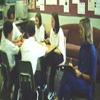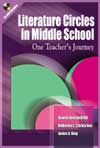| Literature Circles Resource Center | |
| home | site map | structure | books | discussion | written response | themed units | extension projects | |
 |
|
Literature
Circles Structure: Middle School Janine A. King Brighton School Lynnwood, Washington |
How do you get started? As we lay the foundation for literature circles, I’ve found that it works best to have the whole class read the same novel. This sets the stage, providing guided practice with all components of literature circles that students will later apply more independently in their groups formed around book choices. Beginning the year with all students reading the same book gives them a chance to develop the skills, strategies, and behaviors that create the foundation for successful literature circles throughout the year. For this first unit, I choose an engaging book that is accessible to all of my students. This is often a short novel that will lead into a longer book. For example, the sixth graders read The Song of the Trees (1975), then follow up with Roll of Thunder, Hear My Cry (1976), both by Mildred Taylor. This first unit is a training session, so it’s important to go slowly, provide clear modeling, and review my expectations often.
How do you help students understand the purpose of discussion?This first round is really a training session so we go slowly and all procedures are modeled and reviewed. Students need some guidance about what I expect from their literature circle conversations.
• Brainstorming to launch discussions: After students have read several chapters of the whole-class
novel, we prepare for discussion with a short brainstorming session.
I ask the class, “What are some things in these first
chapters that you could talk about fruitfully in your groups?”
I record their ideas on the board for students to refer to
during the discussion. • Fishbowl: Students also need to see and hear examples of discussion in order to begin to understand what to do. I ask the fifth grade teachers for names of students they think are especially good at discussing literature. I then ask five of those students in each reading class to come the following day prepared to discuss The Song of the Trees. In "fish bowl" style these five students sit in the front of the classroom and carry on a discussion about the book while everyone else listens and observes. When the discussion is over, students identify what happened that contributed to a good discussion. These items are recorded on a poster, displayed in the classroom and become our model of strategies for a good discussion. How are the literature circle groups formed? I
find that groups of four or five students work the best.
Larger groups tend to break off into side conversations,
and groups with only three students don’t seem to have enough
energy or diversity of ideas.
I form these first groups myself, making them as heterogeneous
as possible by balancing personalities, gender, and ability levels.
Later, when students choose from an array of books, I form the groups according to students’ choices. I “booktalk” each of the novels, describe some enticing aspects of the book, and give students an idea of the number of pages and level of difficulty. After they’ve head about each book, students take time to examine copies of all of the choices. I suggest that they read a page or two to get a sense of the characters and the overall flavor of the book. Students vote for a first, second, and third choice on a ballot. In my class, this ballot is a blank piece of recycled paper; other teachers use preprinted forms. I can form groups in just a few minutes, honoring each student’s first choice whenever possible. However, I also make some strategic decisions about which students work well together (or not!) and ensure that there are both outgoing and more reticent students balanced among the groups.
How often do students discuss? To fuel a good discussion, students need to be far enough into a book to care about the characters but not so far that they can’t remember details. Each group usually meets for a discussion once a week, resulting in three discussions during the course of reading the book: one near the beginning, one in the middle, and a final discussion after students have completed the whole novel. What does a typical week look like?
What about teaching reading skills? Mini-lessons that focus on reading skills or strategies or literature circle procedures are interspersed throughout each unit where they are most relevant. They usually take about 10 - 15 minutes at the beginning or end of the 45-minute reading period. What do you do when students are finished reading the books? Completing a literature circle unit usually takes 3 to 4 weeks for reading, discussions, and written response. I find that many students naturally gravitate toward various art forms to respond to a book. Therefore, we generally culminate the unit with an extension project. The purpose of this project is to extend their understanding of the book related to the theme of the unit and to celebrate literature. For each unit I usually give students three or four choices of projects. They begin their project by filling out a planning sheet that explains what they are going to do, how they are going to do it, and how it reflects their understanding of the book they read. I usually allow 1 week for students to complete their extension projects during class time.
What do you do the rest of the year? Depending on the class and the yearly schedule, we will do four or five literature circle units during the school year. In-between each unit we take a break for two to four weeks and focus on a non-fiction unit, poetry, or some other area of interest and need. Non-fiction and poetry are great topics for literature circle discussions, too, but I find that changing the format for a few weeks between each literature circle cycle keeps students fresh and interested. |
home
| site map | structure
| books | discussion
| written response
| themed
units | extension projects
|
Literature
Circles Resource Center © 2002 Katherine L. Schlick Noe School of Education Seattle University 900 Broadway Seattle, WA 98122 kschlnoe@seattleu.edu |
